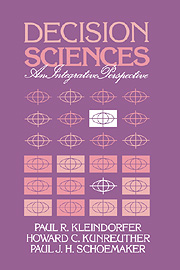2 - Problem finding and alternative generation
Published online by Cambridge University Press: 05 June 2012
Summary
Nature of problem finding
Most research on decision making focuses on how problems are solved. In this chapter, we consider the question of which problems are solved and how alternatives are generated for problem solving. These are fundamental activities underlying effective problem solving and decision making. Clearly, if we spend our time solving the wrong problems, or if we restrict attention to an inferior set of alternative solutions, then no matter how effective our problem-solving procedures may be, the outcome will be poor.
Figure 2.1 reproduces the problem context and problem-finding aspects of Figure 1.2, together with some typical examples of problem finding at various social levels. We note the following descriptive and prescriptive aspects of problem finding of interest:
Problem identification: the process by which a decision maker recognizes that a problem or decision-making opportunity exists.
Problem acceptance: the decision maker focuses attention on the problem as something worth considering further (as opposed to ignoring it).
Problem representation: the problem or decision situation is linked to potential improvements that may be achievable and perhaps some alternatives for problem solving are considered.
From a prescriptive viewpoint, we will be concerned with procedures to improve recognition and acceptance of problem situations. This leads to procedures for clarifying the objectives to be satisfied by problemsolving activity and for improving the management of time and attention so that important problems are dealt with first.
- Type
- Chapter
- Information
- Decision SciencesAn Integrative Perspective, pp. 24 - 64Publisher: Cambridge University PressPrint publication year: 1993



